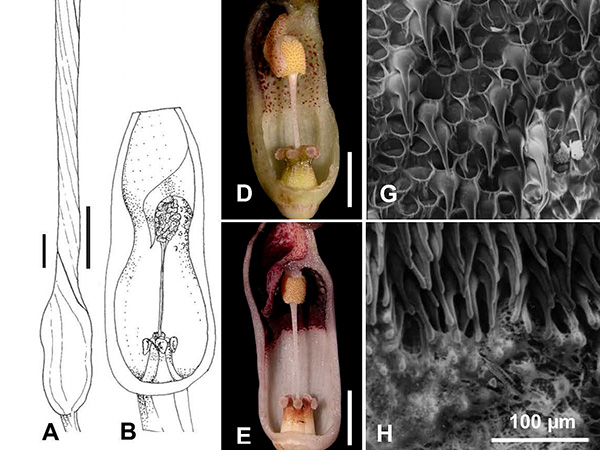Natural hybridization – recombination – an ever-ongoing process
DOI:
https://doi.org/10.20531/tfb.2019.47.1.05Keywords:
Araceae, Chromosome numbers, Cryptocoryne, hybridization, evolutionAbstract
Exemplified by studies of the SE Asian genus Cryptocoryne (Araceae) we provide evidence that: 1) interspecific hybridization is an everongoing process, and introgression and gene exchange takes place whenever physically possible throughout the region; 2) artificial hybridization experiments confirm that wide crosses are possible in a large number of cases; 3) rivers and streams provide numerous, diverse habitats for Cryptocoryne diaspores to settle in; 4) the changes in habitats caused by recurrent glaciations resulting in numerous splitting and merging of populations facilitates hybridization and segregation of subsequent generations; 5) hybridization is a major driving element in speciation; 6) populations are the units and stepping stones in evolution – not the species.
Downloads
References
Arends, J.C., Bastmeijer, J.D. & Jacobsen, N. (1982). Chromosome numbers and taxonomy in Cryptocoryne (Araceae) II. Nordic Journal of Botany 2(5): 453–463.
Bastmeijer, J.D. (2018). The crypts pages. – Published at http://crypts.home.xs4all.nl/Cryptocoryne/index.html [Accessed November 27th, 2017].
Bothmer, R. von, Gustafsson, M. & Snogerup, S. (1995). Brassica sect. Brassica (Brassicaceae) II. Inter- and intraspecific crosses with cultivars of B. oleracea. Genetic Resources and Crop Evolution 42: 165–178.
Bothmer, R. von & Jacobsen, N. (1986). Interspecific crosses in Hordeum (Poaceae). Plant Systematics and Evolution 153: 49–64.
________. (1991). Interspecific Hybrids within the Genus Hordeum. p. 411–431. In P.K. Gupta and T. Tsuchiya ed.: Chromosome Engineering in Plants: Genetics, Breeding, Evolution. Elsevier. Part A.
Boyce, P.C., Sookchaloem, D., Hettterscheid, W.D.A., Gusman, G., Jacobsen, N., Idei, T., & Du, NV. (2012). Flora of Thailand, Acoraceae & Araceae, Vol. 11, 2, p. 218–232 & Plates XLV–LVIII.
Department of Irrigation & Drainage Sarawak. (2017). http://www.did.sarawak.gov.my/modules/web/pages.php?mod=webpage&sub=page&id=320 [Accessed November 27th, 2017].
EPICA. (2004). Eight glacial cycles from an Antarctic ice core. Nature 429: 623–628. https://www.nature.com/articles/nature02599 [Accessed November 27th, 2017].
Erlich, P.R., & Raven, P.H. (1969). Differentiation of Populations. Science 165: 1228–1232. ESRL. (2017). Trends in Atmospheric Carbon Dixoide. https://www.esrl.noaa.gov/gmd/ccgg/trends/ [Accessed November 27th, 2017].
Idei, T., Bastmeijer, J.D. & Jacobsen, N. (2010). Geschichten vom Mekong: Zwei neuen Cryptocorynen (Araceae). Aqua Planta 35(4): 139–146.
________. (2017). Stories from the Mekong, part 2: The Cryptocoryne (Araceae) habitats in the
Chiang Khan district, Loei province, Thailand. Thai Forest Bulletin (Botany) 45(1): 58–78.
Jacobsen, N. (1977). Chromosome numbers and taxonomy in Cryptocoryne (Araceae). Botaniska Notiser 130: 71–87.
________. (1980). The Cryptocoryne albida group of Mainland Asia. Mededelingen Landbouwhogeschool Wageningen 19: 183–204.
________. (1985). The Cryptocoryne of Borneo (Araceae). Nordic Journal of Botany 5: 31–50.
________. (1987). Cryptocoryne. In M.D. Dassanyake & F.R. Forsberg (eds). A revised Handbook to the Flora of Ceylon. IV: 85–99.
Jacobsen, N., Idei, T. & Sookchaloem, D. (2012). ‘11. Cryptocoryne’, in: P.C. Boyce, D. Sookchaloem, W.D.A. Hettterscheid, G. Gusman, N. Jacobsen, T. Idei, & N.V. Du. Flora of Thailand, Acoraceae & Araceae, Vol. 11, 2, p. 218–232 & Plates XLV–LVIII.
Jacobsen, N., Bastmeijer, J.D., Christensen, C., Idei, T., Lange, C.A., Orabi, J., Sookchaloem, D., Toneato, F. &. Ørgaard, M. (2015). The use of AFLP markers to elucidate relationships within Cryptocoryne (Araceae). Aroideana Vol. 38E (1): 186–193.
Jacobsen, N., Bastmeijer, J.D., Bogner, J., Budianto, H., Ganapathy, H.B., Idei, T., Ipor, I.B., Komala, T., Othman, A.S., Rosazlina, R., Siow, J., Wongso, S., & Ørgaard, M. (2016). Hybrids and the Flora of Thailand revisited: Hybridization in the Southeast Asian genus Cryptocoryne (Araceae). Thai Forest Bulletin (Botany) 44(1): 53–73.
Jacobsen, N., Bastmeijer, J.D., Christensen, C., Idei, T., Lange, C.A., Orabi, J., Sookchaloem, D., Toneato, F. & Ørgaard, M. (2017). Cryptocoryne crispatula (Araceae) in Thailand seen with the help of AFLP glasses. 17th Flora of Thailand Conference, 21–25 August 2017, Krabi. E-Poster: 59, p. 143.
Ørgaard, M. & Jacobsen, N. (1998). SE M study of the surface structures of the spathe in Cryptocoryne and Lagenandra (Araceae: Aroideae: Cryptocoryneae). Botanical Journal of the Linnaean Society 126: 261–289.
Othman, A.S., Jacobsen, N. & Mansor, M. (2009). Cryptocoryne of Peninsular Malaysia. Penerbit University Sains Malaysia, Pulau Pinang.
Sathiamurthy, E. & Voris, H.K. (2006). Maps of Holocene sea level transgression and submerged lakes on the Sunda Shelf. - Natural History Journal, Chulalongkorn Univ. Suppl. 2: 1–43.
Voris, H.K. (2000). Maps of Pleistocene sea levels in South-east Asia: shorelines, river systems and time durations. Journal of Biogeography 27: 1153–1167.
Wit, H.C.D. de. (1990). Aquarienpflanzen, 2. Auflage. Ulmer, Stuttgart.
Wongso, S., Bastmeijer, J.D., Budianto, H., Ipor, I.B., Jensen, K.R., Ørgaard, M. & Jacobsen, N. (2017). Six new Cryptocoryne taxa (Araceae) from Kalimantan, Borneo. Willdenowia 47(3): 325–339.



